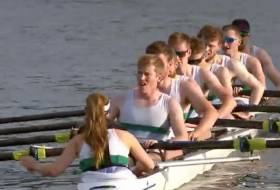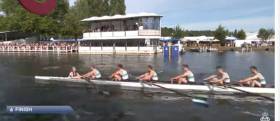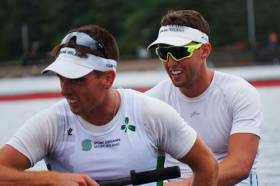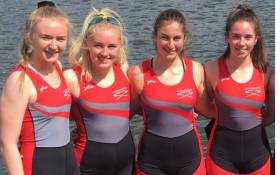Displaying items by tag: commercial
#Rowing: Irish crews had two remarkable wins in quick succession at Henley Royal Regatta on Friday evening.
Commercial came from behind to beat Cercle de l’Aviron de Lyon by three-quarters of a length in the Thames Cup. The French seemed to have a strong hold on the race, but stroke Colm Dowling and his crew rowed through them. The Irish champions then repulsed a late charge to win.
UCD seemed set for a grim battle with RG Dusseldorf and Crefelder in the Visitors’ and there was little between them in the middle stages of the race. But the Irish four – also national champions in this boat – sped away from the Germans across the flat water to win well.
Both crews joined Mark O’Donovan and Shane O’Driscoll, who won in their round of the Silver Goblets, in Saturday’s draw.
Henley Royal Regatta, Day Three (Selected Results; Irish interest)
Thames (Men’s Eight, Club): Commercial bt Cercle de l’Aviron de Lyon ¾ l
Visitors (Men’s Four, Club and University): UCD bt Dusseldorf and Crefeld 2¾ lengths
Hambleden Pairs (Women’s Pairs, Open): G Prendergast, K Gowler bt S O’Connor, N Long 2¼ l
Silver Goblets (Men’s Pairs, Open): Mark O’Donovan and Shane O’Driscoll (Skibbereen) bt H Hogan and H Elworthy 2¼ l
Double Sculls (Men’s Double, Open): J Collins, G Thomas bt Nathan Hull and OJ Dix (Queen’s, Belfast and Leander) 1l
#Rowing: Commercial beat City of Oxford by three and a quarter lengths in the second round of the Thames Cup at Henley Royal Regatta today. The Dublin club left their opponents behind them early on and rowed home under little pressure. They face French opponents, Cercle de l’Aviron de Lyon, on Friday.
Henley Royal Regatta, Day Two (Irish interest)
Thames (Men’s Eight, Club): Commercial bt City of Oxford 3¼ l.
Visitors (Men’s Four, Club and University): UCD bt Leander Club 2¼ l.
Fawley (Junior Men’s Quadruple): Christiana Roklub, Norway bt Enniskillen RBC 1/3 l.
Double Sculls (Men’s Double, Open): Nathan Hull and O Dix (Queen’s, Belfast and Leander) bt MS Cummings and Z Youell 3 1/3 l.
Princess Royal (Women’s Single, Open): JL Cole-Hossian bt Orla Hayes (Skibbereen) easily
Commercial in Command in Heat of Thames Cup at Henley
#Rowing: Commercial moved efficiently through their first outing at Henley Royal Regatta today. The Thames Cup club eight beat Nottingham Rowing Club with little fuss. The Dublin club crew led by a length after half a mile, then established a clearwater lead which they held to the finish line.
Henley Royal Regatta – Day One (Irish interest)
Thames Cup (Men’s Eights, Club): Commercial bt Nottingham RC
O'Driscoll and O'Donovan to Compete at Henley Royal Regatta
#Rowing: The standout names in the Irish entry for Henley Royal Regatta are Mark O’Donovan and Shane O’Driscoll. The world lightweight champions of 2017 have entered the Silver Goblets for open pairs.
The Irish challenge features Commercial in the Thames Cup for club eights and UCD’s four in the Visitors. Both crews are Irish champions. Enniskillen have chosen to enter quadruples in the Fawley and the Diamond Jubilee.
UCD, who compete at Henley Women’s Regatta this weekend, have entered the open event for women’s eights, the Remenham. Orla Hayes of Skibbereen has entered the Princess Royal, the open event for women's single scullers.
Henley Royal Regatta, July 3rd to 7th (Selection of Entries, Irish interest)
Remenham Cup (Women’s Eights, Open): UCD
Thames (Men’s Eight, Club): Commercial
Visitors (Men’s Four, Club and University): UCD
Prince of Wales (Men’s Quadruple, Club and University): Lagan Scullers’
Fawley (Men’s Quadruple, Junior): Enniskillen Royal Boat Club
Diamond Jubilee Cup (Women’s Quadruple, Junior): Enniskillen Royal Boat Club
Britannia (Men’s Fours, coxed, Club): Belfast Rowing Club
Silver Goblets (Men’s Pairs, Open): Mark O’Donovan and Shane O’Driscoll (Skibbereen)
Hambleden Pairs (Women’s Pairs, Open): Sadhbh O’Connor and Natalie Long (NUIG and Skibbereen)
Double Sculls (Men’s Double, Open): Nathan Hull and OJ Dix (Queen’s, Belfast and Leander)
Stonor Trophy (Women’s Double Sculls, Open): Fiona Chestnutt, CK Knight (Reading Univ and Newcastle Univ)
Diamond Sculls (Men’s Single, Open): Callum McCrae (Cambridge Univ Lightweight RC)
Princess Royal (Women’s Single, Open): Orla Hayes (Skibbereen)
#Rowing: Bann won the women's junior 18 eights with some style at Athlone Regatta today. In a battle of Northern Ireland clubs, the women in red and white were two lengths ahead of Enniskillen, with Coleraine GS third.
The women's junior 18 fours came late in the day and was a terrific battle. Commercial produced a cracking finish to win by a length from Enniskillen, with Bann third.
Coleraine's Molly Curry was a convincing winner of the women's junior 18 single, while Brian Colsh of Sligo was the men's junior sculling winner.
Galway's St Joseph's won the men's junior 18 eight, while Bann's good day included a win in the men's junior 18 four.
#Rowing: Commercial won the men's eight in a close and exciting final race of Metropolitan Regatta at Blessington today. UCD and the Irish champions were neck and neck in the final stages, but UCD had the advantage until the sprint to the line, which Commercial won.
The concluding session of finals featured an even closer race.
In the women's four, two junior crews hit the line with just .297 of a second between them. Bann, on the far side of the course from the viewing area, saw their lead snatched away by Castleconnell.
Kenmare's Georgia O'Brien (20) won her singles sculls final with much more to spare, though the second placing gave Aoife Moloney of Commercial victory in the junior 18 rankings.
There were also big margins of victory for Lagan in the men's quadruple and Anna Liffey in the women's pair.
Shane Haugh and James O'Donovan won the men's double. Last weekend O'Donovan was part of the Ireland coxed four which took silver at the European Junior Championships.
UCD Fours Best at Metro Regatta
#Rowing: UCD fours won on the double at Metro Regatta today. The club in blue and saffron took the Division One men's coxless four in a battle with Commercial, while their coxed four also won. Bann's junior 18 eight were the top women's crew, while the women's quad and coxed four from Commercial also won. Killorglin's Rhiannon O'Donoghue and Anna Tyther, both outstanding juniors, were the fastest double. The men's single saw Kealan Mannix of the University of Limerick take the honours in this 150th anniversary regatta, ahead of Niall Beggan of Commercial. Trinity's Mark Quigley and Adam Browne won the men's pair.
Carlow and Castleconnell Notch Up Wins at Ghent
#Rowing: Carlow’s Sadhbh Scully and Keara Egan won the junior 18 women’s double at Ghent regatta on Sunday – first of 18 competing crews. Castleconnell won the women’s junior 18 quadruple, another competitive event, with 10 crews completing the course. Both clubs did well over the two days, as did Three Castles, Methodist College, Belfast, Cork and Commercial, whose senior men’s eight took second on the Sunday.
Ghent Spring Regatta, Belgium (Selected Results; Irish interest):
Saturday
Men
Sculling, Quadruple: 3 Lagan Scullers. Junior: 5 Three Castles.
Double – Jun: 3 Three Castles (L Flynn, A Keogh)
Single – Jun: 5 Cork (P Beechinor) 7:41.32.
Women
Eight – Junior: 1 Commercial 7:25.17.
Four – Jun: 1 Castleconnell 7:32.0, 2 Commercial 7:37.27.
Pair - Senior: 2 Anna Liffey (C Dempsey, D Maguire). Under-23: Cork (J Duggan, C O’Sullivan) 8:11.24. Junior: 1 Cork (J Duggan, C O’Sullivan) 7:59.94, 2 Castleconnell (L O’Brien, N Kiely) 8:04.33.
Sculling
Double – Junior: 5 Carlow.
Lightweight Single: 2 Skibbereen (O Hayes). Under-23: 1 Carlow (K Egan) 8:49.25. Junior: 6 Carlow (S Scully).
Sunday
Men
Eight – Senior: 2 Commercial. Four, coxed- Jun 18: 2 Methodist College, Belfast. Junior 16: 2 Castleconnell.
Sculling, Quadruple: 2 Three Castles.
Double – Jun 18: 4 Cork (Beechinor, M Cronin) 7:08.14.
Single – Under-23 Lightweight: 2 Castleconnell (B Frohburg). Jun 18: 3 Three Castles (Flynn), 5 Three Castles (Tiarnan McKnight), 6 Three Castles (Keogh).
Women
Four – Jun: 1 Commercial 7:41.73, 2 Castleconnell.
Pair – Sen: 3 Anna Liffey (Dempsey, Maguire). Under-23: Cork (Duggan, O’Sullivan) 8:47.59. Jun: Cork (Duggan, O’Sullivan) 8:12.36, 3 Commercial.
Sculling, Quadruple – Jun 18: 1 Castleconnell 7:21.72. Jun 16: 3 Castleconnell, 4 Carlow.
Double – Jun 18: 1 Carlow (Scully, Egan) 7:58.26.
Single – Lightweight: 2 Skibbereen (Hayes). Lwt U-23: 1 Carlow (Egan) 8:56.71. Jun 18: 3 Carlow (Scully); 5 Cork (H Gahan).
Bann Finish Well at Trinity Regatta
#Rowing: Bann closed out the day with two wins at Trinity Regatta. Aaron Christie won the last race of the day, the men's intermediate single. In the previous race, the Coleraine club's women's club eight beat KSRV Njord convincingly - it made up for the earlier women's junior 18 eight final, in which Bann had crossed first but been disqualified.
The men's club eight went to the hosts, who had taken the day in hand early on by winning the men's senior eight. Their women's club, DULBC had won the novice eight.
Commercial were big winners on the day, racking up victories in the men's senior coxed four and pair and the women's and men's club coxed fours. Michael Maher beat clubmate Niall Beggan in the men's senior single on a disqualification.
Neptune won the men's intermediate coxed four and the women's senior double, while Brian Colsh of Sligo took the men's junior 18 single sculls.
#Rowing: The hosts won the men's senior eights title at Trinity Regatta today. The Trinity/Lady Elizabeth crew had a length and a quarter to spare over Blue Star, a British crew which featured Scott Durant, an Olympic gold medallist, along with former Ireland internationals Cormac Folan and Niall Kenny.
The men's senior singles went to Michael Maher after a disqualification. The race featured a clash between the two Commercial men, after which Niall Beggan was disqualified.
The women's novice eight gave DULBC a chance to show their mettle. They raced Neptune in the final and won well. Bann's women's junior 18 eight looked strong and crossed the line ahead of Graiguenamanagh - but Bann were disqualified for not staying the right side of a buoy.
Brian Colsh of Sligo continued his good run by taking the men's junior 18 single, while Galway beat Blackrock in the men's junior 16 eights final.


































































